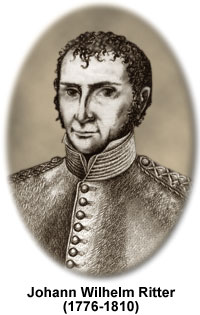Johann Wilhelm Ritter
(1776-1810)

Johann Wilhelm Ritter was a somewhat controversial scientist best known for his discovery of ultraviolet radiation. He was born on December 16, 1776 in Samitz, Germany, an area that is now part of Poland. Apprenticed to an apothecary in Leignitz at the age of fourteen, Ritter developed an acute interest in chemistry that carried over into other scientific fields. When he inherited a sum of money five years later, he was able to leave his position and decided to enroll at the University of Jena. There he studied medicine, staying on in a teaching position after his graduation, until the duke of Saxe-Gotha became his patron in 1802.
Ritter's numerous scientific experiments were diverse, but many of them were concerned with electricity or electrochemistry. One of his earliest studies focused upon the manner in which muscle tissue reacted to electrical charges, research that helped lead him to develop a general theory of nature. Later, in 1800, Ritter duplicated chemist William Nicholson's feat of using electrolysis to decompose water into hydrogen and oxygen, but took the experiment a step farther by collecting the gases discretely. The work led to his invention of the process of electroplating, which is used in modern times to plate gold, silver, and other metals. Additional inventions soon followed, most notably the dry-cell battery in 1802 and an electrical storage battery in 1803.
Ritter's greatest accomplishment, however, is considered his discovery in 1801 of a previously unknown region of the solar spectrum. A year before, William Herschel had announced the existence of the infrared region, which extends past the red region of visible light. Ritter, who believed in the polarity of nature, hypothesized that there must also be invisible radiation beyond the violet end of the spectrum and commenced experiments to confirm his speculation. He began working with silver chloride, a substance decomposed by light, measuring the speed at which different colors of light broke it down. As a result, Ritter confirmed the common belief that violet light was more effective than red (in decomposing silver nitrate) and also demonstrated that the fastest rate of decomposition occurred with radiation that could not be seen, but that existed in a region beyond the violet. Ritter initially referred to the new type of radiation as chemical rays, but the title of ultraviolet radiation eventually became the preferred term.
Despite his significant scientific achievements and his acceptance into the Bavarian Academy of Sciences, Ritter was not well received by his contemporaries. His writing was considered oblique and confusing, and he often delayed explaining his experiments in detail. Some believed Ritter made claims that he could not support and deemed him an unreliable source of information. His interest and studies of occult phenomena further damaged his reputation as a serious scientist. Jaded by his lack of credit and plagued by financial difficulties, Ritter suffered a premature death at the age of thirty-three and did not receive proper recognition for his scientific exploits until more than a century later.
